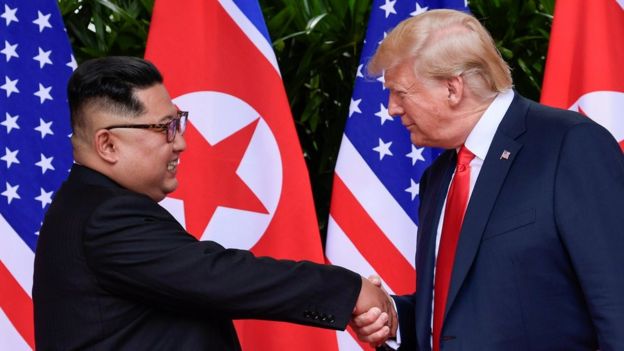North Korean leader Kim Jong-un has agreed to shut one of the country’s main missile testing and launch sites, says the South’s President Moon Jae-in.
After meeting in Pyongyang, the two leaders “agreed on a way to achieve denuclearisation,” said Mr Moon.
The agreement was described by Mr Kim as a “leap forward” towards military peace on the peninsula.
Mr Kim also said he hoped to “visit Seoul in the near future” – he would be the first North Korean leader to do so.
China has welcomed the outcome of the inter-Korean summit, saying both sides had found “new and important common ground”.
What was agreed on denuclearisation?
The main focus of the summit was the issue of denuclearisation. While the US and North Korea agreed in broad terms earlier this year to work towards that goal, negotiations have stalled.
Pyongyang has now sought to reconfirm its commitment.
Mr Moon said Mr Kim had “agreed to permanently close the Tongchang-ri missile engine test site and missile launch facility” and, crucially, that this would be done “in the presence of experts from relevant nations”.
The BBC’s Seoul correspondent Laura Bicker said allowing independent inspectors to see the dismantling of the Tongchang-ri site was a major step forward.
She added that satellite images had suggested that Tongchang-ri was in the process of being destroyed, but that the declaration would allow inspectors to verify the process.
- Tongchang-ri has been North Korea’s main satellite launch facility since 2012, according to monitoring group 38 North.
- It has also been used for testing engines for North Korean missiles capable of reaching the US.
He said Mr Kim had also agreed to shut down the Yongbyon nuclear facility – where North Korea is believed to have produced the material used in its nuclear tests – but only if the US took some reciprocal action. The details of that were not specified.

North Korea blew up its main nuclear testing site at Punggye-ri shortly before Mr Kim’s meeting with US President Donald Trump in June.
“The outcome is a big win for Moon Jae-in, who has managed to extract a series of positive headlines from Kim Jong-un related to denuclearisation,” Ankit Panda, editor of The Diplomat, told the BBC.
READ: Islamic State in West Africa kill hundreds of soldiers – Sources
“None of the concessions are truly costly to Kim and won’t help move North Korea toward short-term disarmament, but provide a further basis for confidence building on which US-North Korea talks can move forward.”
What about North-South relations?
The two countries also made advances on inter-Korean ties, announcing plans to link up their railways, allow more reunions for families separated by war and co-operate on health care.
Mr Moon invited the North Korean leader to Seoul, suggesting the visit should take place before the end of this year.
They will also seek to co-host the 2032 Summer Olympics.

The South’s defence minister and the head of the North Korean army also signed an agreement to reduce military tensions, establishing a buffer zone along the border to prevent accidental clashes.
The signing came mid-way through a three-day visit to Pyongyang by Mr Moon.
While it is the first trip to the North Korean capital in a decade by a leader from the South, it is Mr Moon’s third meeting with Kim Jong-un since their historic summit in April.
What does this mean for the US?
Efforts towards denuclearisation between the North and the US had recently hit a deadlock and this week’s Pyongyang summit will bolster the South’s role as a mediator.
Mr Trump was quick to tweet his applause for the Moon-Kim summit.
Kim Jong Un has agreed to allow Nuclear inspections, subject to final negotiations, and to permanently dismantle a test site and launch pad in the presence of international experts. In the meantime there will be no Rocket or Nuclear testing. Hero remains to continue being……..
— Donald J. Trump (@realDonaldTrump) September 19, 2018
The US and North Korea held their own historic meeting in June when Mr Trump and Mr Kim agreed in broad terms to work towards denuclearisation.
Since then though, there’s been little progress with no clear process nor timeline laid out.

Most observers warn that so far the North has taken no meaningful steps to end its controversial nuclear weapons programme and this week’s summit might not be enough to convince them otherwise.
“For instance, the commitment to shutting down the Yongbyon complex is premised on reciprocal US measures, which raises difficulties,” warns Mr Panda. “Washington will have to help move the needle here and it’s unclear if the Trump administration can do that.”
Mr Trump recently said that he and Mr Kim would “prove everyone wrong”, after he received an invitation from the North Korean leader for a second summit. Both sides say they are working on making that meeting happen.












